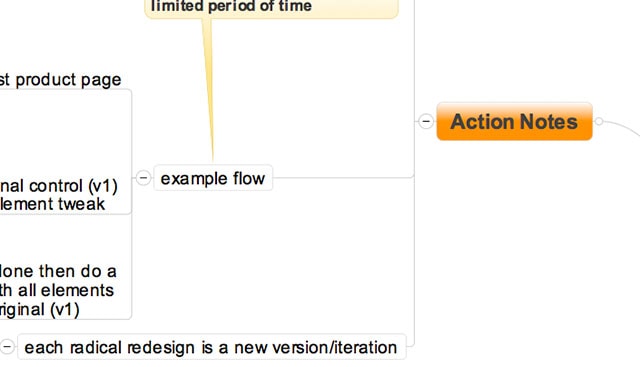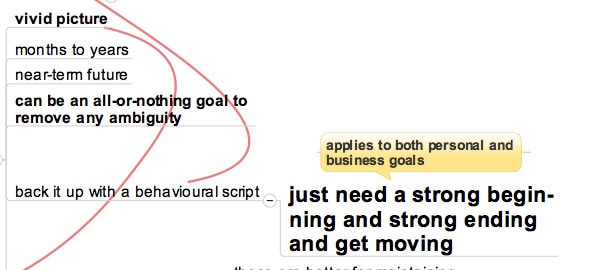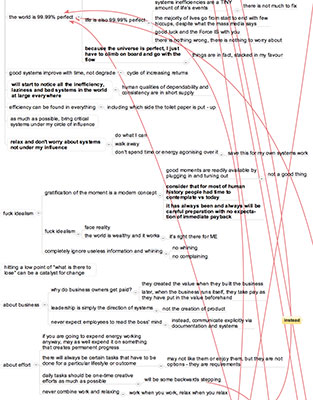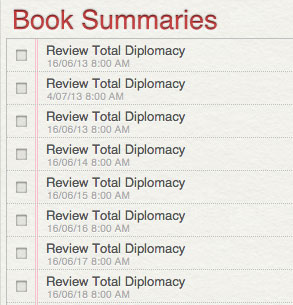
Mind maps are a fantastic way to capture information and ideas. They also happen to be our preferred way to capture information from books and other written media.
Why mind maps? Because it is much faster to review a mind map than it is an entire book. You can get all the main ideas of a book from just reading the first-level nodes of your summary mind map, and if you need more granularity, you can drill down into each node to find what you’re looking for. Mind maps are ideal for creating effective book summaries.
Here’s a simple 4-step process for reading and creating an accessible mind map for future review.
Quick Summary
- What you’ll need. The tools you will need to pull this off.
- 4-Step Process. 4 simple steps to go from book to easily reviewable mind map.
What You’ll Need
You need 3 things:
- The book. This is obvious. If you can get the book in digital form (be that Kindle, iBooks/EPUB or PDF), that’s even better.
- Mind mapping app. We personally like MindJet MindManager. We’ve also used Mind Node (but it’s not as pretty) and Freemind (free, but really not as pretty).
- A basic task manager, for setting review dates. We like OmniFocus. You can also use a built-in Reminders app like the one on OS X or Outlook to set reminders for specific dates.

4-Step Process
1. Establish Your Purpose

The first thing you want to do is establish your purpose for reading the book. Is there something you want to know or learn about in particular? Is there a set of beliefs you would like to reinforce with what you read in the book?
Whatever your purpose is (expanding knowledge, completing coursework, application) you need to know it and it needs to be clear from the get-go. Without it, you’ll be reading without direction and it will be much more difficult to mentally sort out relevant information for your mind map.
2. Read the Book

This is really straightforward – read the book!
Use a highlighter and pencil to take notes if you like, or if you’re on a tablet or other digital device then you can easy highlight/note within your reading app.
3. Mind Map

After you’ve read the book, you want to sit down and create your mind map.
This will reinforce what you’ve just read and learned, and also lets you rearrange the content of the book to better match your own way of thinking, rather than relying on the author’s chapters and structure. It essentially lets you filter the content of the book through the lens of your established purpose.
Here are some technicalities when it comes to mind mapping a book:
- You can mind map by chapters or major concepts. If you like the author’s structure, go with chapters. If not, create your own based on what you think are the main concepts.
- 8-12 top-level nodes is enough. Try to make the 1-4 word phrases, e.g., “task management principles”.
- You can drill down into as deep a level of detail as you like. If a particular idea is more important to you than another, then go deep on that.
- Have one node called “Implementation” or “Action”. I like to color mine a bright orange. Under this node, list all the Actions from the book that you will take – things that you’ve read, highlighted and then noted as “oh, I need to implement this”. This forms a handy reference list that you can look at and then simply do.

- Highlight important ideas on your mind map by using different colored text or nodes, or bolding or increasing font size.
- Use callouts where necessary. Our preferred usage for callouts is for “ideas about ideas” – perhaps a personal comment about a given idea we’ve written down in the mind map.

- Use relationships to tie together different parts of the book. If one concept naturally leads into another or needs to reference another, draw a relationship line between the two.

4. Rearrange
When you’re done with the mind map, get up and go get a glass of water or walk around for a bit.
Then come back, and rearrange the information in the mind map so that it makes sense to you. Remember that it’s going to be you who is reviewing it down the line.
5. Schedule and Review
Bonus step!
If you want to systemize your reviews, open up your Reminders application or task manager and create a list that looks like this:

Set yourself task reminders to review the mind map at these intervals:
- 3 days later
- 3 weeks later
- 3 months later
- 1 year later
- 2 years later
- 3 years later
- 4 years later
- 5 years later
During each review, look over the main concepts and drill down to where you want more detail. Look at the Action Node and see what you’ve implemented – or not.
Where to Go Next
Now you have a simple 4-step process for reading and creating effective book summaries with mind maps.
If you want to learn to read faster, check out our article on speed reading.
Or if you’re looking for a good book to test this out on, check out the Asian Efficiency Primer – it’s a collection of our best content, all in one accessible volume.

I did a site search
site:asianefficiency.com getabstract
site:asianefficiency.com soundview
to see if AI had anything on book summaries.
Over 20 years ago I bought “The Great American Bathroom Book” vols I-III and while I know reading the actual book gives a person something they won’t get by reading summaries, there is a time and place for summaries. Those three books above I’ve spent hours with, they’re fantastic imo.
As far as digital and business related books, there are some competing book summaries companies out there and wanted to know which one AI recommended.
1 gives the raw number of book summaries available, getabstract is way ahead
2 says that soundview is still the best in their opinion, comparing the samples each offers, I agree – but to me volume is key so getabstract has the advantage at this point in time
1
https://www.wsj.com/articles/SB1036436969914097508
2
https://www.google.com/webhp?sourceid=chrome-instant&ion=1&espv=2&ie=UTF-8#safe=off&q=site%3Aasianefficiency.com%20getabstract
Thanks,
Scott
what is lacking is discussion on how to manage those huge mindmaps which are difficult to print and too small to read on the computer screen.
Any reason they can’t be read on a computer screen? I have quite a few of those and don’t have any problem reading them.